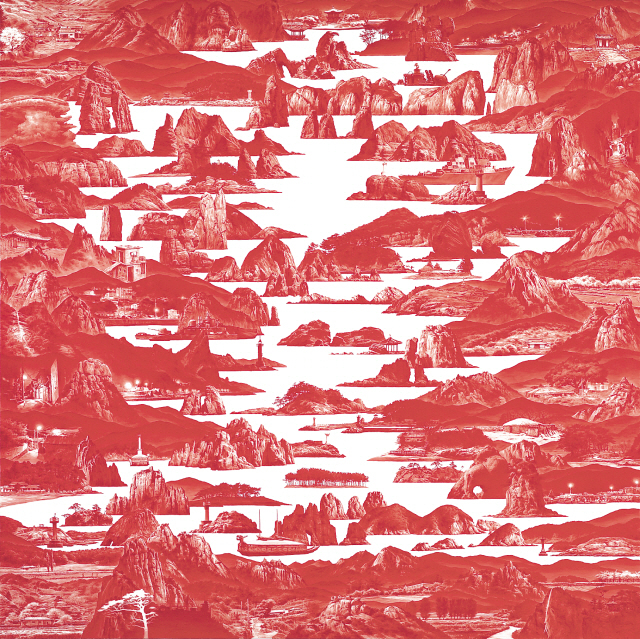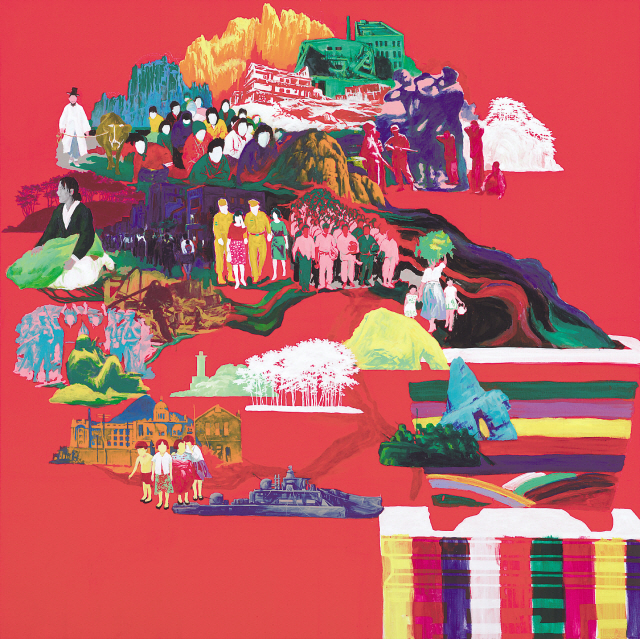Lee Sea-hyun presents his interpretation of Korean landscape and modern history in vivid colors
Korean artist Lee Sea-hyun, once acclaimed as the artist who can best portray his country by the famous Swiss art collector Uli Sigg, has brought new interpretation of Korean society and landscape to the Korean audience.
Well-known for the red landscape painting series “Between Red,” Lee took his artistic endeavor to the next level with his new “Rainbow” series along with four sculptures for an upcoming exhibition in Seoul.
Korean artist Lee Sea-hyun, once acclaimed as the artist who can best portray his country by the famous Swiss art collector Uli Sigg, has brought new interpretation of Korean society and landscape to the Korean audience.
Well-known for the red landscape painting series “Between Red,” Lee took his artistic endeavor to the next level with his new “Rainbow” series along with four sculptures for an upcoming exhibition in Seoul.

While staying in England at the age of 37, Lee began to draw Korean landscapes exclusively in red as seen in images observed through the visual and visible light detecting scope used by the military, in an attempt to interpret the division of Korea.
“It felt like a great dereliction of duty to not interpret the reality of the divided country through the eyes of a Korean artist,” said Lee at the press meeting before opening of his solo exhibition at Hakgoje last week.
Having painted Korean landscape that way for six years since 2006, he felt it was time to try new things.
Lee added vivid yellow, blue and green to better portray the social and political circumstances in modern Korean history and its landscape while still using red as the dominant color.
“I use the vivid colors that I saw at shaman temples when I was young. The combination of red, blue, yellow and green at the shaman temples came to me as a bright image, but with slightly weird feeling. I am expressing the cruel reality and painful records of the turbulent history of modern Korea and unbalanced development using the contrasting vivid colors,” said Lee.
In his “Rainbow” painting, people who might have existed at some point in modern Korean history form fragments of major historical events with Korean mountains, prominent historical buildings and soldiers and a submarine in the background.

In a painting in the series “Rainbow in Green,” Lee expressed the shock he felt when he found out that the place where he had scattered his mother’s ashes had disappeared due to a development project. Lee depicted the village and surrounding landscape in green and spattered oil paint on linen.
Lee said that seeing the landscape damaged by rapid development somehow changed his use of color from red to other colors.
“I had to use different ways to depict the disharmony in Korean landscape,” said Lee.
His visits to many places in Korea after he returned from England in 2009 led him to adopt diverse ways to express what he saw.
He saw many military bunkers in the northern border city of Paju where his studio is located, and put together a single sculpture work called “Shangri-La” using cement and iron bars.
“I named it paradoxically because a military bunker can be interpreted as a utopian place because it is the only place that can protect soldiers’ lives in a war,” said Lee.
The villages, mountains and rivers are all based on what he saw during his trips to various places in Korea or in photos.
“I try to resemble the old painter Jeong Seon who bravely defied the dominant influence of Chinese art and established a unique painting technique that better depicts the Korean landscape,” said Lee, who declares Jeong as the true pioneer of Korean contemporary art.
“And I also thought over and over how to better reinterpret the current Korean landscape.”
Lee Sea-hyun’s solo exhibition “Plastic Garden” will run from Aug. 29-Oct. 14 at Hakgoje, Samcheong-dong, Seoul.
For more information, call (02) 739-4937.
By Lee Woo-young (wylee@heraldcorp.com)




![[Herald Interview] 'Amid aging population, Korea to invite more young professionals from overseas'](http://res.heraldm.com/phpwas/restmb_idxmake.php?idx=644&simg=/content/image/2024/04/24/20240424050844_0.jpg&u=20240424200058)












![[KH Explains] Korean shipbuilding stocks rally: Real growth or bubble?](http://res.heraldm.com/phpwas/restmb_idxmake.php?idx=652&simg=/content/image/2024/04/25/20240425050656_0.jpg&u=)

